
The Complete Guide to New York City Train Vacations

Experience the Ultimate New York City Train Vacation
Planning a New York City train vacation is one of the most exciting ways to explore the vibrant culture, iconic landmarks, and bustling energy of the Big Apple. Traveling by train offers a comfortable, scenic, and stress-free alternative to driving or flying, allowing you to relax and enjoy the journey as much as the destination.
With convenient routes arriving at Penn Station, you can easily access world-famous attractions like Times Square, Central Park, and Broadway theaters. Plus, booking your train tickets along with car rentals and hotel accommodations through a single platform makes your trip seamless and hassle-free.
Whether you’re visiting for a weekend getaway or an extended vacation, a New York City train vacation combines convenience, comfort, and unforgettable experiences into one perfect package.
What are the top attractions to visit on a train vacation in New York City?
New York City is packed with world-famous sights and hidden gems, making it a perfect destination for a train vacation. When you arrive in Manhattan-right at the heart of the action-here are the must-visit attractions to include in your itinerary:
1. Times Square
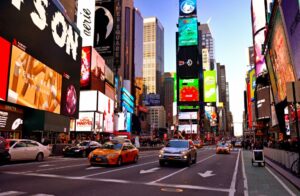
Times Square is a world-famous entertainment and commercial hub in Midtown Manhattan, renowned for its dazzling digital billboards, Broadway theaters, and vibrant atmosphere. Often called “the Crossroads of the World,” it attracts over 50 million visitors annually and is the iconic site of New York City’s annual New Year’s Eve ball drop. The iconic crossroads of the world! Experience the dazzling lights, Broadway theaters, and the electric energy of NYC’s most famous square.
How did Times Square become the heart of New York’s entertainment industry?
Times Square became the heart of New York’s entertainment industry through a combination of strategic location, transportation development, and the migration of theaters and nightlife to the area in the early 20th century. Originally known as Longacre Square, the transformation began in 1904 when The New York Times moved its headquarters there, prompting the city to rename the area “Times Square” and sparking a surge in illuminated advertising and public events, such as the first New Year’s Eve ball drop.
By World War I, most legitimate theaters had relocated from downtown to Times Square, establishing it as the center of the American theater industry and earning it the nickname “The Great White Way” due to its dazzling electric lights. The arrival of the subway and other transit lines made Times Square a major transportation hub, drawing both city dwellers and visitors from the suburbs, which fueled its growth as a gathering place for entertainment, commerce, and celebration. Over the decades, the area attracted world-famous performers, iconic Broadway productions, and a vibrant nightlife, making Times Square synonymous with New York’s entertainment scene.
Today, Times Square remains a global symbol of urban excitement and show business, continually reinventing itself as the epicenter of theater, advertising, and cultural spectacle.
2. Central Park

Escape the city buzz with a stroll, bike ride, or picnic in this sprawling green oasis. Don’t miss the Central Park Zoo, Bow Bridge, and rowboat rentals at the Loeb Boathouse.
Central Park is an iconic urban oasis in the heart of Manhattan, stretching 843 acres between the Upper West Side and Upper East Side neighborhoods. Designed by Frederick Law Olmsted and Calvert Vaux and opened in 1858, it is the first landscaped park in the United States and remains the most visited urban park in the country, attracting over 42 million visitors annually.
The park is celebrated for its diverse landscapes, including sprawling meadows, tranquil lakes, woodlands, and scenic bridges, as well as its many attractions such as the Central Park Zoo, Wollman Rink, Bethesda Terrace and Fountain, Bow Bridge, Belvedere Castle, and the Conservatory Garden. Central Park also features more than 70 works of art, miles of walking and biking paths, and hosts numerous cultural events and performances throughout the year. With its rich history, natural beauty, and cultural significance, Central Park offers both locals and visitors a peaceful escape and a vibrant gathering place in the midst of New York City’s bustling energy.
What are the most popular attractions within Central Park today?
The most popular attractions within Central Park today include:
Bethesda Terrace and Bethesda Fountain: A stunning two-level architectural feature with a grand fountain, often featured in films and a central gathering spot.
Belvedere Castle: Offering panoramic views of the park and Turtle Pond from one of its highest points.
The Mall and Literary Walk: A majestic promenade lined with American elm trees and statues of famous writers, perfect for leisurely strolls.
Sheep Meadow: A 15-acre open lawn popular for picnics, sunbathing, and people-watching.
Strawberry Fields: A memorial to John Lennon featuring the iconic “Imagine” mosaic and a peaceful garden setting.
Conservatory Garden: A formal garden divided into French, Italian, and English-style sections, ideal for a tranquil escape.
Bow Bridge: An elegant cast-iron bridge known for its romantic setting and scenic views.
Central Park Zoo: A family-friendly attraction housing a variety of animals and interactive exhibits.
Wollman Rink: A seasonal ice skating rink that transforms into a Victorian-style amusement park in summer.
The Obelisk (Cleopatra’s Needle): The oldest outdoor monument in NYC, dating back to ancient Egypt.
These highlights represent just a fraction of Central Park’s diverse offerings, blending natural beauty, art, history, and recreation in one iconic urban oasis.
3. The Metropolitan Museum of Art
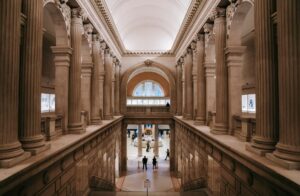
One of the world’s greatest art museums, “The Met” houses masterpieces from ancient to modern times. Art lovers can easily spend a full day here.
The Metropolitan Museum of Art, known as The Met, stands as one of the world’s premier art institutions, celebrated for its vast and diverse collections, architectural grandeur, and cultural significance.
The Met is the largest art museum in the Americas and the most-visited in the United States, housing over 1.5 million works spanning 5,000 years of global culture. Its collections include masterpieces from ancient Egypt, classical antiquity, European Old Masters, American art, and extensive holdings in Asian, African, Islamic, and modern art. The museum’s architectural evolution, from its original 1880 Gothic-Revival building to its iconic Beaux-Arts facade and modern wings, makes it a landmark both for its art and its design. Its location along Central Park and the Museum Mile further enhances its appeal, offering visitors not only world-class art but also stunning views and a vibrant cultural atmosphere.
How has the Met’s collection evolved over its 150-year history
Over its 150-year history, the Metropolitan Museum of Art’s collection has evolved from a Eurocentric and classical focus to a truly global, encyclopedic representation of human creativity. Founded in 1870 to bring art and education to the American public, The Met’s earliest acquisitions centered on European paintings, antiquities, and decorative arts, quickly establishing its reputation as a major repository of classical and Western art.
Throughout the 20th century, the museum expanded both its physical footprint and its collecting scope. Landmark acquisitions included the Cesnola Collection of Cypriot antiquities, the establishment of the Costume Institute, and the opening of The Met Cloisters for medieval art. By the mid-1900s, the museum began to embrace a broader vision, adding significant collections of Islamic, Asian, African, Oceanic, and American art, and creating new wings to house these works. The 1982 opening of a dedicated wing for art from Africa, Oceania, and the ancient Americas marked a major step toward global inclusivity.
A pivotal moment came in 1967 with the creation of the Department of Contemporary Arts, led by Henry Geldzahler, which integrated modern and contemporary works into the museum’s holdings and exhibitions. This shift helped bridge the gap between historical and modern art, positioning The Met as a leader in presenting art across time and cultures.
In recent decades, The Met has actively sought to diversify its collection, acquiring important works from underrepresented regions and cultures, and embracing new media and contemporary voices. Major gifts—such as the Leonard A. Lauder Cubist Collection and the Souls Grown Deep Foundation’s African American art—have further enriched its holdings. Today, the museum’s 2 million objects, spread across 17 curatorial departments and more than 2 million square feet of gallery space, reflect a commitment to presenting global visual culture as a web of intersecting narratives told through multiple perspectives.
The Met’s evolution has been shaped by visionary curators, landmark exhibitions, and a dedication to conservation and public engagement, ensuring that its collection remains dynamic, relevant, and representative of the world’s artistic heritage.
4. Statue of Liberty & Ellis Island

Take a ferry from Battery Park to visit these enduring symbols of American freedom and immigration.
The Statue of Liberty and Ellis Island are two of the most iconic and historically significant sites in the United States, symbolizing freedom, opportunity, and the immigrant experience.
The Statue of Liberty, officially named “Liberty Enlightening the World,” was a gift from France to the United States, conceived in 1865 by French intellectual Edouard de Laboulaye and designed by sculptor Auguste Bartholdi. The statue was constructed in France, assembled in Paris between 1881 and 1884, and then shipped to the U.S., where it was reassembled on Liberty Island in New York Harbor and dedicated in 1886. The monument commemorates the U.S. centennial of independence and the enduring friendship between France and America. Its torch and crown have become universal symbols of liberty and hope for millions of immigrants arriving in the United States.
Today, Liberty Island is home not only to the statue itself but also to the Statue of Liberty Museum, which features interactive exhibits, the original torch, and panoramic views of New York Harbor. Visitors can explore the grounds, climb to the pedestal or, with advance reservations, ascend to the crown for breathtaking views.
Ellis Island
Located nearby, Ellis Island served as the nation’s busiest immigration station from 1892 to 1924, processing over 12 million immigrants during America’s largest wave of migration. For many, Ellis Island was the “Gateway to the New World,” where hopes for a new life began. The main building, now the Ellis Island National Museum of Immigration, preserves this legacy with exhibits, artifacts, and personal stories of those who passed through its halls. Nearly 40% of Americans can trace at least one ancestor to Ellis Island.
5. Empire State Building
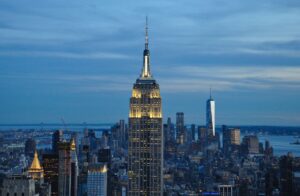
Ride to the top for breathtaking views of the city skyline-especially magical at sunset or after dark.
The Empire State Building is one of New York City’s most iconic landmarks and a marvel of 20th-century engineering. Completed in 1931 after just 410 days of construction, it rises 1,250 feet (380 meters) to its top floor and 1,454 feet (443 meters) including its spire and antenna, making it the tallest building in the world until 1971 and currently the fourth tallest in New York City. The building features 102 stories, with observation decks on the 86th and 102nd floors that attract millions of visitors annually for sweeping views of Manhattan and beyond. The Empire State Building continues to be a major tourist destination, hosting over 2.5 million visitors each year, and remains a powerful symbol of New York City’s skyline and spirit.
6. Broadway and the Theater District
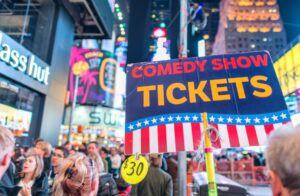
Catch a world-class musical or play in the legendary Broadway district. Be sure to book tickets in advance for popular shows!
Broadway and the Theater District in Manhattan are the historic and cultural heart of American live theater, renowned worldwide for their vibrant musicals, plays, and performances. The district’s origins date back to the early 19th century when theaters began moving uptown from downtown Manhattan, with significant development around 42nd Street and Times Square by the early 1900s. This area earned the nickname “The Great White Way” due to the dazzling electric lights and billboards that illuminated Broadway, making it one of the first electrified streets in the U.S.
The Theater District grew rapidly in the early 20th century as theaters like the New Amsterdam and Lyceum opened, establishing Times Square as the epicenter of theatrical production. The 1920s and 1930s marked Broadway’s Golden Age with a surge of musicals and plays that set new artistic standards. Despite a decline in the 1970s marked by urban decay and seedy venues, the district experienced a major revival in the 1990s, fueled by family-friendly shows like The Lion King and Beauty and the Beast, and the efforts to preserve historic theaters.
Today, Broadway is synonymous with American theater excellence, hosting professional theaters with 500+ seats each, and featuring a diverse range of productions from blockbuster musicals to innovative plays. It remains a major economic and cultural driver for New York City, attracting millions of visitors annually and influencing global theater.
7. 9/11 Memorial & Museum

The 9/11 Memorial & Museum stands as a powerful tribute to the victims, survivors, and heroes of the September 11, 2001 and 1993 World Trade Center attacks, offering visitors a moving and educational experience in Lower Manhattan.
This world-renowned site features two striking reflecting pools marking the footprints of the original Twin Towers, surrounded by a tranquil plaza of swamp white oak trees. The adjacent underground museum offers deeply immersive exhibits, artifacts, personal stories, and interactive displays that honor the nearly 3,000 victims and explore the events, aftermath, and ongoing impact of 9/11. The experience is both solemn and healing, with accessible facilities, guided tours, and resources for visitors of all ages.
This unique museum offers a more intimate perspective on the aftermath of 9/11, showcasing Marlon Suson’s powerful photographs and artifacts from the recovery effort at Ground Zero. It provides a personal and educational complement to the main memorial and museum, with guided tours and interactive exhibits suitable for families and visitors seeking a deeper understanding of the recovery process.
8. Grand Central Terminal
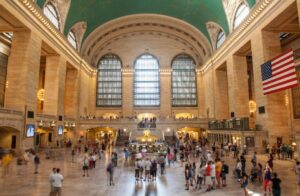
A destination in itself, this architectural marvel is perfect for train lovers and history buffs. Enjoy shopping, dining, and the famous celestial dome.
Grand Central Terminal, opened in 1913 in Midtown Manhattan, is a monumental Beaux-Arts train station and one of New York City’s most iconic landmarks. It was built to replace earlier stations dating back to 1871, designed by the firms Reed and Stem (overall design) and Warren and Wetmore (architectural detailing), as part of a major modernization prompted by a deadly 1902 steam train crash that led to electrification and underground routing of trains. The terminal features a vast main concourse with a stunning celestial ceiling mural, 44 platforms serving 63 tracks—making it the world’s largest train station by number of platforms—and a grand facade adorned with sculptures and a famous clock.
Originally serving multiple railroads including the New York Central & Hudson River Railroad, it became a central hub for commuter and intercity rail travel. Despite threats of demolition in the mid-20th century, Grand Central was preserved and designated a New York City landmark in 1967. A major restoration in the 1990s revitalized the terminal, uncovering its original starry ceiling and transforming it into a vibrant transit hub with retail, dining, and cultural spaces. The recent completion of the East Side Access project in 2023 now connects the Long Island Rail Road directly to Grand Central, further enhancing its role as a vital transportation center.
Grand Central Terminal is celebrated not only for its architectural grandeur and engineering innovations—such as high-level platforms and a balloon roof train shed—but also as a cultural icon and bustling gateway to New York City.
Key Highlights:
-
Opened February 2, 1913, replacing earlier stations from 1871 and 1900
-
Designed by Reed & Stem and Warren & Wetmore in Beaux-Arts style
-
Features 44 platforms and 63 tracks, largest in the world by platform count
-
Famous celestial ceiling mural in the main concourse
-
Landmark status granted in 1967, major restoration in the 1990s
-
East Side Access project (2023) connects Long Island Rail Road to Grand Central
-
Houses retail shops, restaurants, Metro-North Railroad commuter lines, and cultural spaces
Grand Central remains a vibrant transportation hub and architectural masterpiece, symbolizing New York’s history, innovation, and enduring spirit.
9. Museum of Modern Art (MoMA)
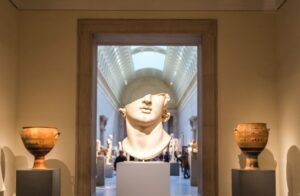
The Museum of Modern Art (MoMA) is a world-renowned institution in New York City, celebrated for its influential role in shaping the history and appreciation of modern and contemporary art.
MoMA is recognized for its groundbreaking collection of modern and contemporary art, featuring masterpieces from van Gogh, Picasso, Warhol, and Monet, as well as its dedication to innovation in architecture, photography, design, and film. The museum’s history of pioneering exhibitions, commitment to diversity and new media, and its dynamic expansion projects make it a must-visit destination for art lovers and cultural explorers.
As an affiliate of MoMA, MoMA PS1 in Queens is dedicated to experimental and contemporary art, hosting cutting-edge shows and live performances in a unique, repurposed school building. It offers a distinct experience from the main MoMA campus, focusing on emerging artists and innovative programming.
How does the accessibility at MoMA enhance my visit experience

Accessibility at MoMA significantly enhances your visit by ensuring that everyone—regardless of ability—can fully experience and enjoy the museum’s world-class art and programs. All galleries, entrances, and facilities are wheelchair accessible, with power-assist doors, elevators, and accessible restrooms available on nearly every floor. If you use a wheelchair or have difficulty standing, you can skip ahead in lines simply by alerting a staff member, making navigation stress-free.
MoMA’s commitment goes beyond physical access:
-
Visitors with disabilities receive discounted admission, and care partners enter free.
-
Service animals are welcome throughout the museum.
-
Special accommodations—including American Sign Language (ASL) interpretation, CART, and audio description—are available for public programs with advance notice.
-
Sensory maps help identify quieter spaces, places to sit, and areas with tactile activities, supporting visitors with sensory sensitivities.
-
Programs for blind and low-vision visitors include touch tours and detailed verbal descriptions of artworks, available in-person and through the Bloomberg Connects app.
-
Create Ability and other monthly programs welcome visitors with intellectual and developmental disabilities, offering interactive activities and social guides to ease the visit.
-
Staff receive ongoing disability equality training, ensuring a welcoming, respectful, and knowledgeable environment for all visitors.
MoMA’s accessibility initiatives—including sensory-friendly hours, tactile experiences, and inclusive programming—make the museum a leader in universal design and visitor experience, fostering a sense of belonging and engagement for every guest.
10. Brooklyn Bridge

Walk or bike across this historic bridge for stunning views of Manhattan and Brooklyn.
The Brooklyn Bridge, completed in 1883, is a landmark suspension bridge connecting Manhattan and Brooklyn across the East River. Designed by John A. Roebling and completed under the supervision of his son Washington Roebling—with crucial assistance from Washington’s wife, Emily Roebling—the bridge was the longest suspension bridge in the world at the time, with a main span of 1,595.5 feet. It was the first to use steel cables and incorporated innovative engineering techniques such as pneumatic caissons for the towers’ foundations.
Construction began in 1870 and faced numerous challenges, including worker injuries and fatalities, a fire in the Brooklyn caisson, and material scandals. Despite these setbacks, the bridge’s iconic neo-Gothic stone towers and steel-wire suspension system created a structure both strong and elegant. The Brooklyn Bridge features a raised pedestrian promenade and bicycle path, offering stunning views of the Manhattan skyline and the East River. Today, it remains a National Historic Landmark and a symbol of New York City’s engineering prowess and architectural beauty.
How Book Your Train Trip Enhances Your NYC Experience?
With Book Your Train Trip, you don’t just get a train ticket-you get a complete travel solution:
-
Train tickets from your city to Penn Station, NYC
-
Hotel bookings near top attractions
-
Car rentals for exploring beyond Manhattan
-
Custom tour packages including guided visits to major sights
Let us handle the logistics so you can focus on making memories at New York City’s best attractions!
New York City, the city that never sleeps, is a dream destination for millions. While planes and cars are common ways to arrive, there’s a unique charm and convenience to experiencing the city by train. With Book Your Train Trip, planning your perfect New York City train vacation has never been easier. From booking your train tickets to arranging hotels and car rentals, we handle every detail so you can focus on enjoying the journey and the destination.
Why Choose a Train Vacation to New York City?
Scenic and Stress-Free Travel
Forget about airport hassles, traffic jams, and parking fees. Traveling by train offers a relaxing and scenic alternative. Sit back, enjoy the countryside views, and arrive refreshed in the heart of Manhattan at Penn Station.
Environmentally Friendly
Train travel is a more sustainable option than flying or driving. Reduce your carbon footprint while enjoying a comfortable and convenient journey.
Cost-Effective
When you factor in baggage fees, airport transfers, and parking costs, train travel can be surprisingly affordable. Plus, with Book Your Train Trip, you can find package deals that combine train tickets, hotels, and attractions for even greater savings.
How Book Your Train Trip Makes Planning Easy?
Train Ticket Booking
Our user-friendly platform allows you to search and book train tickets from anywhere in the country. Simply enter your departure city, destination (New York City), and travel dates, and we’ll show you a range of options from Amtrak and other rail providers.
Hotel Reservations
We partner with top hotels in New York City to offer you a variety of accommodation options to suit your budget and preferences. Whether you’re looking for a luxury hotel in Midtown, a boutique hotel in Greenwich Village, or a budget-friendly option in Long Island City, we’ve got you covered.
Car Rental Services
Want to explore beyond Manhattan? We can arrange car rentals from major providers like Avis, Hertz, and Enterprise. Pick up your car at Penn Station or any other convenient location and discover the hidden gems of the Tri-State area.
Customized Tour Packages
Let us create a tailor-made tour package that includes train tickets, hotel accommodations, guided tours, and attractions. Whether you’re interested in Broadway shows, museum visits, historical landmarks, or culinary experiences, we can design a package that perfectly matches your interests.
The Classic New York City Experience (5 Days/4 Nights)
Day 1: Arrive at Penn Station, check into your hotel, and take a walk through Times Square.
Day 2: Visit the Statue of Liberty and Ellis Island, followed by a stroll through the Financial District.
Day 3: Explore Central Park, visit the Metropolitan Museum of Art, and catch a Broadway show.
Day 4: Discover Greenwich Village, SoHo, and Little Italy, and enjoy a delicious dinner in Chinatown.
Day 5: Depart from Penn Station.
The Family Adventure (7 Days/6 Nights)
Day 1: Arrive at Penn Station and check into your family-friendly hotel.
Day 2: Visit the American Museum of Natural History and the Children’s Museum of Manhattan.
Day 3: Spend the day at Coney Island, enjoying the beach, boardwalk, and amusement park.
Day 4: Take a ferry to Staten Island for views of the Statue of Liberty and the Manhattan skyline.
Day 5: Explore the Bronx Zoo and the New York Botanical Garden.
Day 6: Visit the Intrepid Sea, Air & Space Museum and enjoy a harbor cruise.
Day 7: Depart from Penn Station.
Frequently Asked Questions (FAQs)
Q1: What are the best train routes to New York City?
A: Amtrak offers multiple routes to New York Penn Station, including the Northeast Regional, Acela Express, and long-distance lines connecting cities like Boston, Washington D.C., Chicago, and Miami. These routes provide convenient and comfortable access to NYC.
Q2: How can I book my train tickets, car rental, and hotel for my NYC trip?
A: At Book Your Train Trip, we simplify your travel planning by allowing you to book your train tickets, car rentals, and hotel accommodations all in one seamless process. This saves you time and ensures a smooth, coordinated trip to New York City.
Q3: What amenities are available on Amtrak trains to NYC?
A: Amtrak trains feature spacious seating, free Wi-Fi, power outlets, café or dining cars, and private sleeper cabins on select routes. Penn Station and Moynihan Train Hall offer easy access to NYC’s subway system and luggage services.
Q4: Can I combine my train trip with sightseeing tours or other activities?
A: Yes! Through our platform, you can add sightseeing tours, event tickets, and other activities to your NYC train vacation package, creating a customized and hassle-free itinerary.
Q5: What are the top attractions accessible from New York Penn Station?
A: Penn Station is centrally located near iconic sites such as Times Square, the Empire State Building, Madison Square Garden, and the High Line. With nearby subway connections, you can easily explore all of Manhattan and beyond.
Q6: Are there day trips or weekend getaways from NYC by train?
A: Absolutely! Popular destinations like Hudson Valley towns, Philadelphia, Washington D.C., and the Hamptons are easily reachable by train. We can help you plan and book these trips including transportation and accommodation.
Q7: How far in advance should I book my New York City train vacation?
A: For the best prices and availability, it’s recommended to book your train tickets, car rental, and hotel at least 2–3 months in advance, especially during peak travel seasons.
Q8: Can I bring my bike or pet on the train to NYC?
A: Many Amtrak routes allow bicycles and small pets with advance reservations and applicable fees. We can assist you in adding these options to your booking.
Q9: What is the luggage policy on trains to New York City?
A: Amtrak allows two carry-on bags and two personal items per passenger, with checked baggage available on select routes. Our team can provide guidance on luggage policies to ensure a smooth journey.
Q10: How do I modify or cancel my bookings?
A: Changes and cancellations depend on fare types and policies. When you book through Book Your Train Trip, our customer support team is available to assist you with any modifications or cancellations.
New York Train Vacations | Best Train Tours & Packages in NYC | Book Your Train Trip
Ready to experience the magic of New York City by train? Contact Book Your Train Trip today to start planning your unforgettable adventure. Our expert team is standing by to answer your questions and help you create the perfect itinerary. Let us take care of the details so you can focus on making memories that will last a lifetime.

Visit us online at www.bookyourtrain-trip.com call us at 18884577599.




